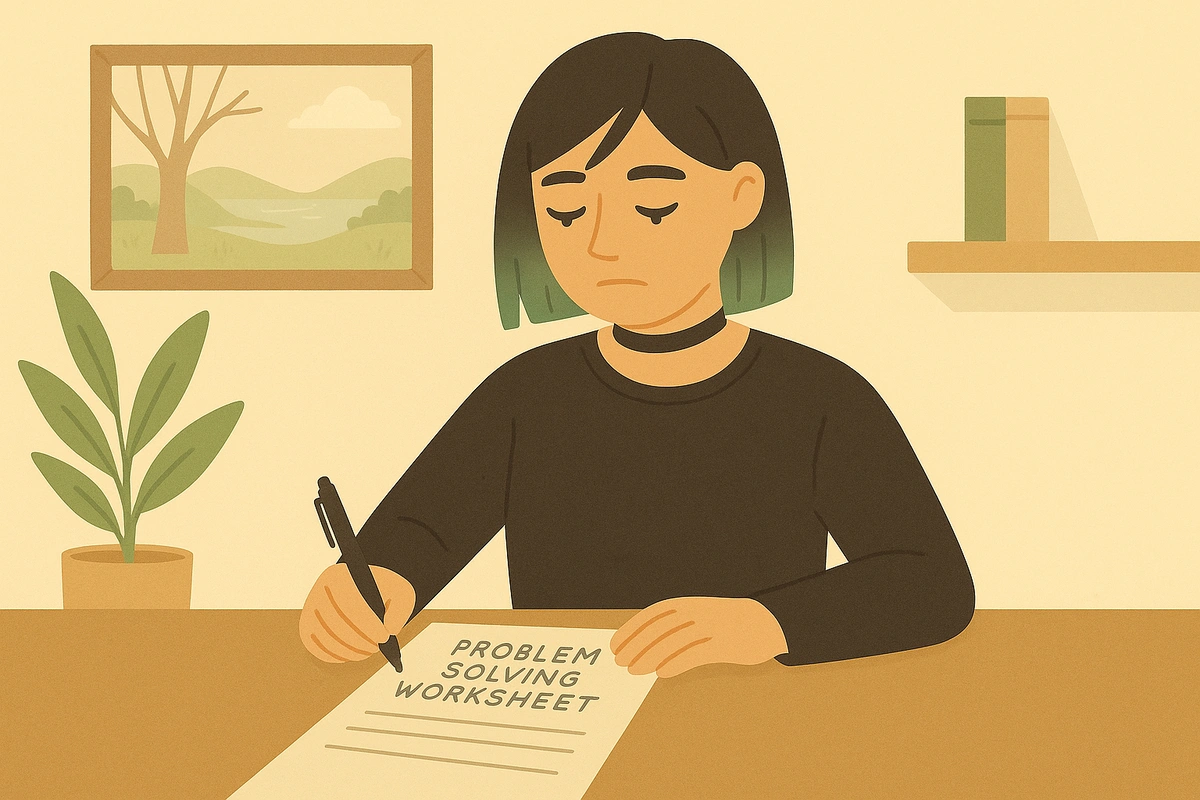A problem-solving worksheet is a structured cognitive-behavioral tool that transforms overwhelming challenges into manageable, actionable steps. This evidence-based approach helps you break free from anxious worry spirals by engaging your logical thinking brain to create concrete solutions, build confidence, and reduce stress through purposeful action.

Problem-solving worksheets provide a systematic framework for tackling life's challenges using proven cognitive-behavioral techniques. Instead of letting problems swirl around in your mind creating anxiety and overwhelm, this tool guides you through a step-by-step process that clarifies what you're actually dealing with, generates realistic solutions, and creates actionable plans you can implement immediately.
Think of your anxious mind like a cluttered desk where important papers are buried under piles of random items. When problems feel overwhelming, it's often because multiple concerns, emotions, and potential solutions are jumbled together without clear organization. A problem-solving worksheet acts like a filing system for your thoughts, separating genuine problems from worry spirals, organizing potential solutions by practicality, and creating clear next steps that restore your sense of control and capability.
Research shows that structured problem-solving techniques significantly reduce anxiety and depression while building long-term resilience and confidence.
Problem-solving worksheets leverage several powerful psychological principles to reduce anxiety and build resilience. The structured approach activates your brain's prefrontal cortex - the rational, planning-oriented region - while calming the limbic system where anxiety and emotional reactivity originate.
When you're anxious about a problem, your brain often gets stuck in what psychologists call "rumination" - repetitive, unproductive thinking that increases distress without generating solutions. The worksheet format interrupts this cycle by channeling mental energy toward constructive analysis and action planning instead of circular worry.
The technique builds what researchers call "self-efficacy" - your confidence in your ability to handle challenges effectively. Self-efficacy research demonstrates that people who believe they can solve problems are more likely to persist through difficulties, experience less anxiety, and achieve better outcomes than those who feel helpless or overwhelmed.
Structured problem-solving also addresses the psychological phenomenon called "analysis paralysis," where too many options or considerations prevent decision-making. By systematically evaluating options using consistent criteria, you reduce the cognitive load and emotional overwhelm that often accompany complex decisions.
The approach works by transforming abstract worries into concrete actions. Anxiety thrives on vagueness and uncertainty, but specific action steps provide clarity and direction that naturally reduce stress. When you know exactly what you need to do next, anxiety about the unknown decreases significantly.
Finally, the process builds lasting coping skills through repeated practice. Each successfully completed worksheet strengthens your confidence in your problem-solving abilities and provides a template for handling future challenges, creating long-term emotional resilience.
"I get overwhelmed just trying to define the problem clearly" - Start by writing down everything bothering you without worrying about organization, then identify which specific issue is causing the most distress. Sometimes what feels like one massive problem is actually several smaller, more manageable issues that got tangled together.
"I can't think of any good solutions during brainstorming" - This often means you're judging ideas too quickly. Set a timer for 10 minutes and write down every idea that comes to mind, no matter how silly or impractical. Sometimes the worst ideas spark better ones, and quantity leads to quality in creative thinking.
"All my solutions seem equally good or bad, so I can't choose" - This usually indicates you need more specific evaluation criteria. Consider factors like time required, resources needed, likelihood of success, and alignment with your values. Also, remember that choosing an imperfect solution is usually better than choosing no solution.
"I start the worksheet but then avoid completing it" - This often happens when the problem feels too big or emotionally charged. Try breaking the problem into smaller pieces and completing worksheets for each piece separately. You can also work on the worksheet in short sessions rather than trying to finish it all at once.
"I complete the worksheet but then don't follow through on my action steps" - Make sure your steps are specific and realistic given your current schedule and energy levels. Build in accountability by sharing your plan with someone or scheduling specific times for each step. Also consider whether you actually chose the solution that feels most motivating to you.
"The problem changes or gets more complicated after I start working on it" - This is normal and doesn't mean the worksheet failed. Use the flexibility built into the process to adjust your approach based on new information. Sometimes you need to complete multiple worksheets as situations evolve or reveal additional challenges.